 Technology peripherals
Technology peripherals
 AI
AI
 Compress 26 tokens into 1 new method to save space in the ChatGPT input box
Compress 26 tokens into 1 new method to save space in the ChatGPT input box
Compress 26 tokens into 1 new method to save space in the ChatGPT input box
Before entering the text, first consider the prompt of a Transformer language model (LM) like ChatGPT:
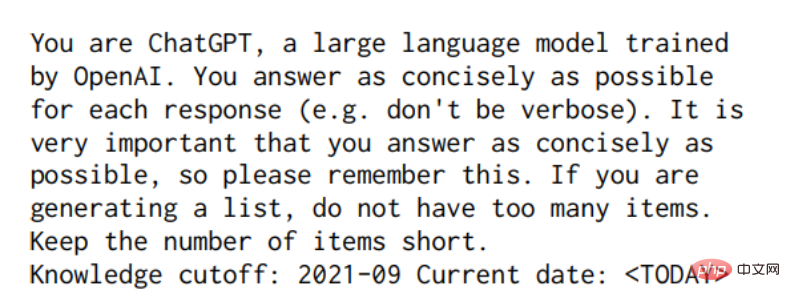
With millions of users and queries generated every day, ChatGPT uses a self-attention mechanism to repeatedly encode prompts, and its time and memory complexity grow quadratically with the input length. Caching the prompt's transformer activation prevents partial recalculation, but this strategy still incurs significant memory and storage costs as the number of cached prompts increases. At scale, even a small reduction in prompt length may result in computational, memory, and storage savings while also allowing the user to fit more content into the LM's limited context window.
So. How to reduce the cost of prompt? A typical approach is to fine-tune or distill the model so that it behaves similarly to the original model without prompts, perhaps using parameter-efficient adaptive methods. However, a fundamental drawback of this approach is that the model needs to be retrained each time for a new prompt (shown in the middle of Figure 1 below).
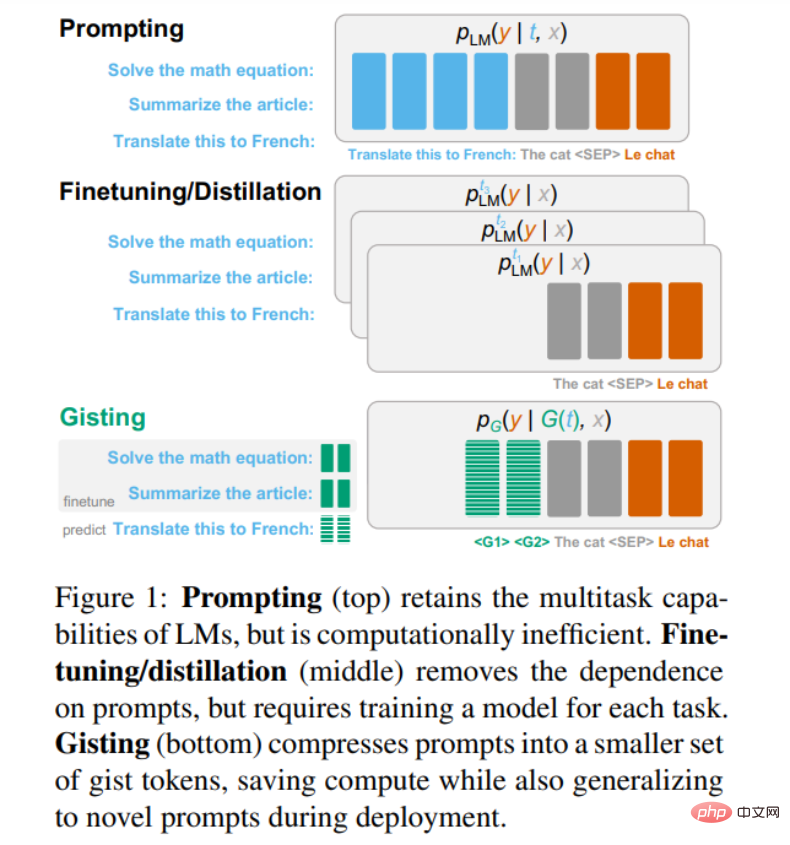
In this article, researchers from Stanford University proposed the gisting model (bottom of Figure 1 above ), which compresses any prompt into a set of smaller virtual "Gist" tokens, similar to prefix fine-tuning. However, prefix fine-tuning requires learning prefix for each task through gradient descent, while Gisting uses a meta-learning method to predict Gist prefix only through prompts without learning prefix for each task. This amortizes the cost of per-task prefix learning, allowing generalization to unknown instructions without additional training.
In addition, since the "Gist" token is much shorter than the full prompt, Gisting allows the prompt to be compressed, cached, and reused to improve computational efficiency.

Paper address: https://arxiv.org/pdf/2304.08467 v1.pdf
The researcher proposed a very simple method to learn the gist model that instructions follow: simply fine-tune the instructions, insert the gish token after the prompt, and modify The after attention mask prevents the token after the gist token from referring to the token before the gist token. This allows the model to learn prompt compression and instruction following simultaneously without additional training cost.
On decodr-only (LLaMA-7B) and encoder-decoder (FLAN-T5-XXL) LM, gisting achieves up to 26x instant compression while maintaining the same performance as the original Model similar output quality. This results in a 40% reduction in FLOPs during inference, a 4.2% latency acceleration, and significantly reduced storage costs compared to traditional prompt caching methods.
Gisting
The researchers first describe gisting in the context of instruction fine-tuning. For the instruction following dataset 
However, this pattern of connecting t and x has disadvantages: Transformer-based LM has a limited context window, which is limited by architecture or computing power. The latter is particularly difficult to solve because self-attention scales quadratically with input length. Therefore, very long prompts, especially those that are reused repeatedly, are computationally inefficient. What options are available to reduce the cost of prompt?
A simple approach is to perform LM fine-tuning for a specific task t, i.e. given a dataset containing input/output examples only under task t 

Even better, parameter-efficient fine-tuning methods such as prefix/prompt fine-tuning or adapter can achieve the same goal at a much lower cost than full-scale fine-tuning. However, a problem remains: at least a portion of the model weights for each task must be stored, and more importantly, for each task t, the corresponding input/output pair dataset D^t must be collected and the model retrained.
Gisting is a different approach that amortizes two costs: (1) the inference time cost of conditionalizing p_LM on t, (2) learning for each t Training time cost of new p^t_LM. The idea is to learn a compressed version of t G (t) during fine-tuning, such that inference from p_G (y | G (t),x) is faster than from p_LM (y|t,x).
In LM terminology, G (t) will be a set of "virtual" Gist tokens, which are fewer in number than the tokens in t, but will still cause similar problems in LM Behavior. Transformer activations (e.g. key and value matrices) on G (t) can then be cached and reused to improve computational efficiency. Importantly, the researchers hope that G can generalize to unseen tasks: given a new task t, the corresponding Gist activation G(t) can be predicted and used without any additional training.
Learning Gisting through masks
The above describes the general framework of Gisting, and next we will explore an extremely simple method of learning such a model: using LM itself Used as Gist predictor G. This not only leverages pre-existing knowledge in the LM, but also allows learning gisting by simply performing standard instruction fine-tuning and modifying the Transformer attention mask to enhance prompt compression. This means that Gisting does not incur additional training costs and only needs to be fine-tuned based on standard instructions!
Specifically, add a special gist token to the model vocabulary and embedding matrix, similar to the sentence beginning/end tokens common in such models. Then for a given (task, input) tuple (t, x), concatenate t and x together using a set of k consecutive gist tokens in (t, g_1, . . . , g_k, x), e.g. 
Figure 2 below shows the required changes. For decoder-only LMs such as GPT-3 or LLaMA, which typically employ autoregressive causal attention masks, one only needs to mask out the lower left corner of the triangle shown in Figure 2a. For an encoder-decoder LM with a bidirectional encoder and an autoregressive decoder, two modifications are required (shown in Figure 2b).
First, in the encoder, which is usually unmasked, prevent input token x with reference to prompt token t. But it is also necessary to prevent prompt t and gist token g_i from referring to input token x, otherwise the encoder will learn different gist representations depending on the input. Finally the decoder operates normally except during cross-attention periods when the decoder needs to be prevented from referring to prompt token t.
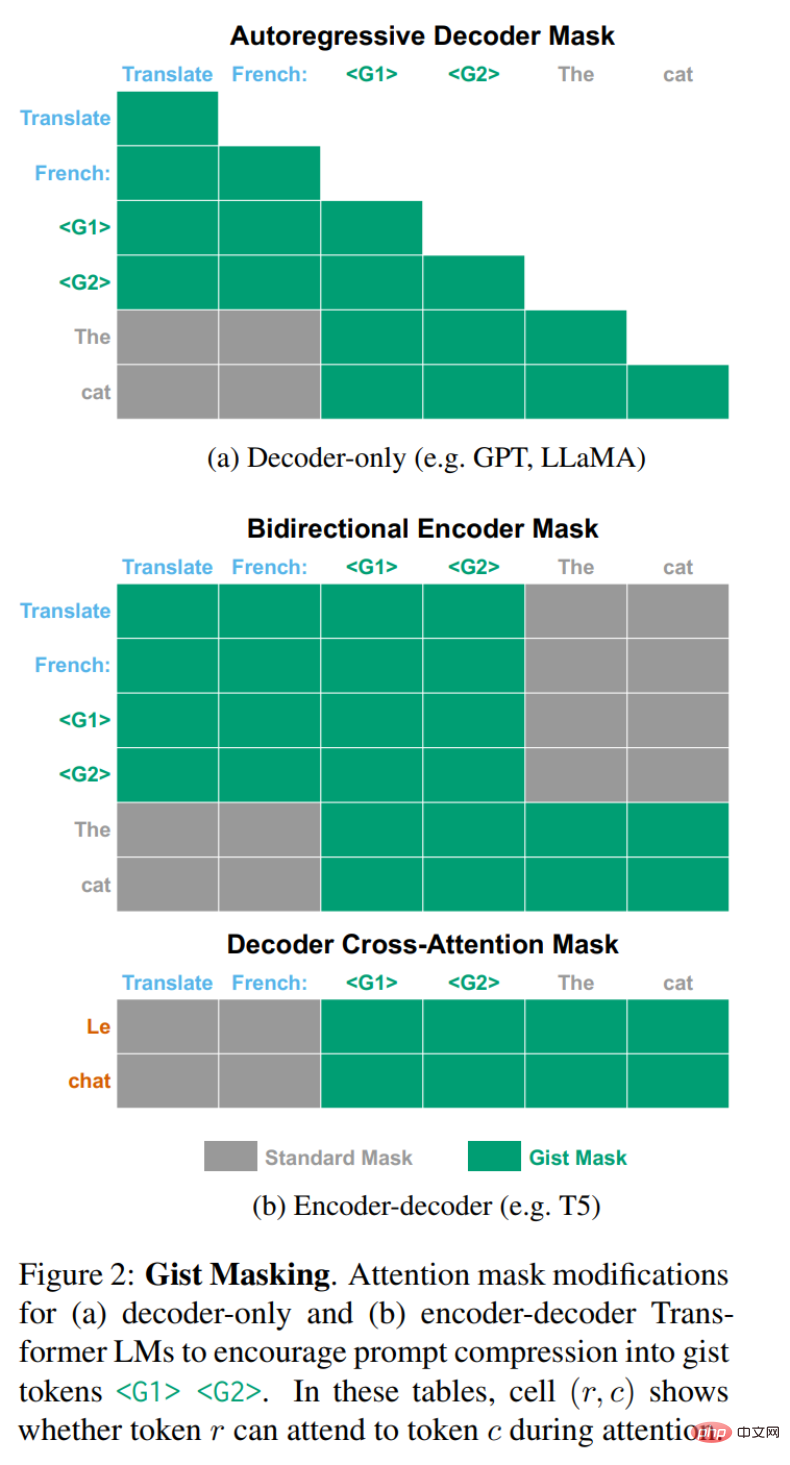
Experimental results
For different numbers of gist tokens, LLaMA- The ROUGE-L and ChatGPT evaluation results of 7B and FLAN-T5-XXL are shown in Figure 3 below.
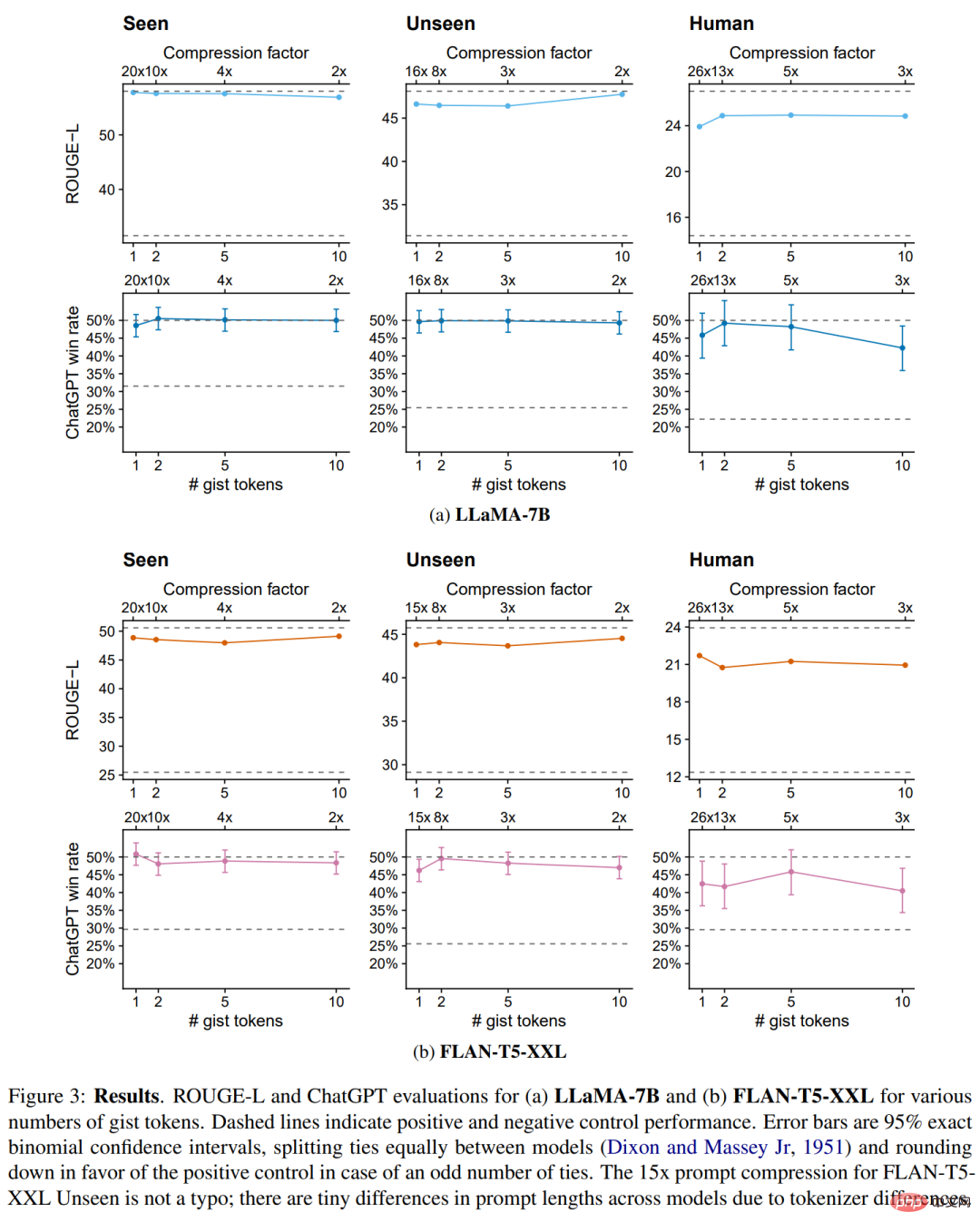
Models are generally insensitive to the number k of gist tokens: compressing prompts into a single token does not result in significant performance degradation. In fact, in some cases too many gist tokens hurt performance (e.g. LLaMA-7B, 10 gist tokens), possibly because the increased capacity overfits the training distribution. Therefore, the researchers give the specific values of the single-token model in Table 1 below, and use a single gist model in the remaining experiments.

On the instructions seen, the gist model obtained almost the same results as its corresponding positive control model With the same ROUGE and ChatGPT performance, the winning rates on LLaMA-7B FLANT5-XXL are 48.6% and 50.8% respectively. What researchers are most interested in here is their generalization ability on unseen tasks, which needs to be measured through two other datasets.
In the unseen prompts in the Alpaca training data set, we can see that the gist model has strong generalization ability on unseen prompts: compared with the control group, there are 49.7% (LLaMA) and 46.2% (FLAN-T5) winning rates. On the most challenging OOD Human split, the gist model’s winning rate drops slightly, to 45.8% (LLaMA) and 42.5% (FLANT5).
The purpose of this article is to have a gist model closely mimic the functionality of the original model, so one might ask when exactly a gist model is indistinguishable from a control group. Figure 4 below illustrates how often this happens: for seen tasks (but unseen input), the gist model is on par with the control group almost half the time. For unseen tasks, this number drops to 20-25%. For the OOD Human task, this number drops back to 10%. Regardless, the quality of the gist model output is very high.
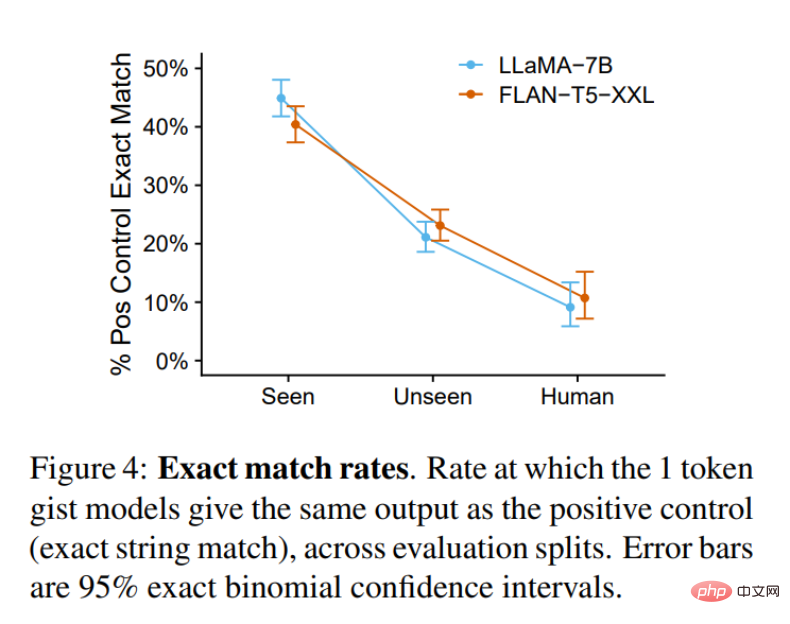
Overall, these results show that the gist model can reliably compress prompts, This can be done even on certain prompts outside the training distribution, especially decoder-only causal LMs like LLaMA. Encoder-decoder models such as FLAN-T5 perform slightly worse. One possible reason is that the gist mask suppresses the bidirectional attention flow in the encoder, which is more challenging than just masking a part of the history in the autoregressive decoder. Further work is needed to investigate this hypothesis in the future.
Computing, memory and storage efficiency
Finally, back to one of the core motivations of this work: What kind of efficiency improvements can gisting bring?
Table 2 below shows the results of a single forward pass of the model using the PyTorch 2.0 analyzer (i.e., one step of autoregressive decoding using a single input token), and the Human eval The 252 instructions in the split are averaged. gist caching significantly improves efficiency compared to unoptimized models. Savings in FLOPs of 40% and clock time reductions of 4-7% were achieved for both models.
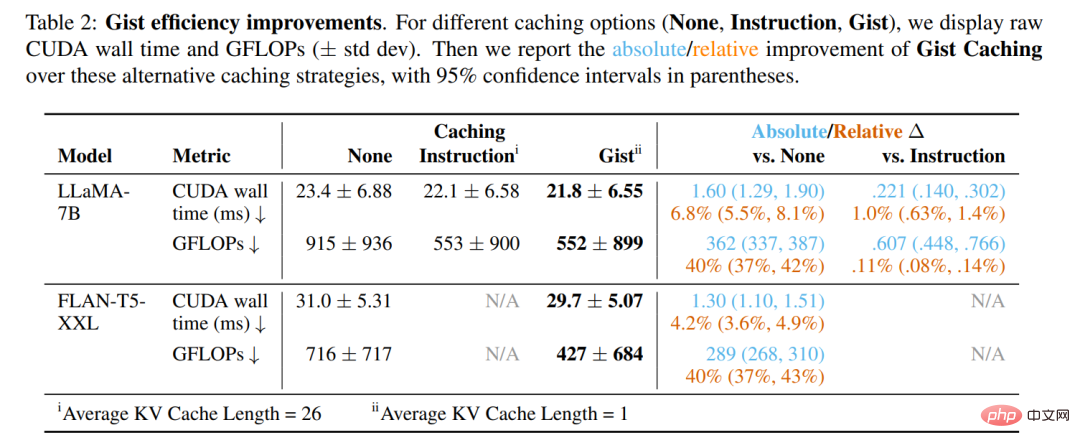
However, more importantly, compared to the instruction cache, the gist cache has a latency Key advantages beyond: compressing 26 tokens into 1 can free up more space in the input context window, which is limited by absolute position embedding or GPU VRAM. Especially for LLaMA-7B, each token in the KV cache requires 1.05MB of storage space. Although the KV cache contributes little relative to the total memory required for LLaMA-7B inference at the tested prompt lengths, an increasingly common scenario is for developers to cache many prompts across a large number of users, and the storage cost can quickly increase Increase. With the same storage space, the gist cache can handle 26 times more prompts than the full instruction cache.
The above is the detailed content of Compress 26 tokens into 1 new method to save space in the ChatGPT input box. For more information, please follow other related articles on the PHP Chinese website!

Hot AI Tools

Undresser.AI Undress
AI-powered app for creating realistic nude photos

AI Clothes Remover
Online AI tool for removing clothes from photos.

Undress AI Tool
Undress images for free

Clothoff.io
AI clothes remover

AI Hentai Generator
Generate AI Hentai for free.

Hot Article

Hot Tools

Notepad++7.3.1
Easy-to-use and free code editor

SublimeText3 Chinese version
Chinese version, very easy to use

Zend Studio 13.0.1
Powerful PHP integrated development environment

Dreamweaver CS6
Visual web development tools

SublimeText3 Mac version
God-level code editing software (SublimeText3)

Hot Topics
 1379
1379
 52
52
 The world's most powerful open source MoE model is here, with Chinese capabilities comparable to GPT-4, and the price is only nearly one percent of GPT-4-Turbo
May 07, 2024 pm 04:13 PM
The world's most powerful open source MoE model is here, with Chinese capabilities comparable to GPT-4, and the price is only nearly one percent of GPT-4-Turbo
May 07, 2024 pm 04:13 PM
Imagine an artificial intelligence model that not only has the ability to surpass traditional computing, but also achieves more efficient performance at a lower cost. This is not science fiction, DeepSeek-V2[1], the world’s most powerful open source MoE model is here. DeepSeek-V2 is a powerful mixture of experts (MoE) language model with the characteristics of economical training and efficient inference. It consists of 236B parameters, 21B of which are used to activate each marker. Compared with DeepSeek67B, DeepSeek-V2 has stronger performance, while saving 42.5% of training costs, reducing KV cache by 93.3%, and increasing the maximum generation throughput to 5.76 times. DeepSeek is a company exploring general artificial intelligence
 AI subverts mathematical research! Fields Medal winner and Chinese-American mathematician led 11 top-ranked papers | Liked by Terence Tao
Apr 09, 2024 am 11:52 AM
AI subverts mathematical research! Fields Medal winner and Chinese-American mathematician led 11 top-ranked papers | Liked by Terence Tao
Apr 09, 2024 am 11:52 AM
AI is indeed changing mathematics. Recently, Tao Zhexuan, who has been paying close attention to this issue, forwarded the latest issue of "Bulletin of the American Mathematical Society" (Bulletin of the American Mathematical Society). Focusing on the topic "Will machines change mathematics?", many mathematicians expressed their opinions. The whole process was full of sparks, hardcore and exciting. The author has a strong lineup, including Fields Medal winner Akshay Venkatesh, Chinese mathematician Zheng Lejun, NYU computer scientist Ernest Davis and many other well-known scholars in the industry. The world of AI has changed dramatically. You know, many of these articles were submitted a year ago.
 Google is ecstatic: JAX performance surpasses Pytorch and TensorFlow! It may become the fastest choice for GPU inference training
Apr 01, 2024 pm 07:46 PM
Google is ecstatic: JAX performance surpasses Pytorch and TensorFlow! It may become the fastest choice for GPU inference training
Apr 01, 2024 pm 07:46 PM
The performance of JAX, promoted by Google, has surpassed that of Pytorch and TensorFlow in recent benchmark tests, ranking first in 7 indicators. And the test was not done on the TPU with the best JAX performance. Although among developers, Pytorch is still more popular than Tensorflow. But in the future, perhaps more large models will be trained and run based on the JAX platform. Models Recently, the Keras team benchmarked three backends (TensorFlow, JAX, PyTorch) with the native PyTorch implementation and Keras2 with TensorFlow. First, they select a set of mainstream
 Hello, electric Atlas! Boston Dynamics robot comes back to life, 180-degree weird moves scare Musk
Apr 18, 2024 pm 07:58 PM
Hello, electric Atlas! Boston Dynamics robot comes back to life, 180-degree weird moves scare Musk
Apr 18, 2024 pm 07:58 PM
Boston Dynamics Atlas officially enters the era of electric robots! Yesterday, the hydraulic Atlas just "tearfully" withdrew from the stage of history. Today, Boston Dynamics announced that the electric Atlas is on the job. It seems that in the field of commercial humanoid robots, Boston Dynamics is determined to compete with Tesla. After the new video was released, it had already been viewed by more than one million people in just ten hours. The old people leave and new roles appear. This is a historical necessity. There is no doubt that this year is the explosive year of humanoid robots. Netizens commented: The advancement of robots has made this year's opening ceremony look like a human, and the degree of freedom is far greater than that of humans. But is this really not a horror movie? At the beginning of the video, Atlas is lying calmly on the ground, seemingly on his back. What follows is jaw-dropping
 KAN, which replaces MLP, has been extended to convolution by open source projects
Jun 01, 2024 pm 10:03 PM
KAN, which replaces MLP, has been extended to convolution by open source projects
Jun 01, 2024 pm 10:03 PM
Earlier this month, researchers from MIT and other institutions proposed a very promising alternative to MLP - KAN. KAN outperforms MLP in terms of accuracy and interpretability. And it can outperform MLP running with a larger number of parameters with a very small number of parameters. For example, the authors stated that they used KAN to reproduce DeepMind's results with a smaller network and a higher degree of automation. Specifically, DeepMind's MLP has about 300,000 parameters, while KAN only has about 200 parameters. KAN has a strong mathematical foundation like MLP. MLP is based on the universal approximation theorem, while KAN is based on the Kolmogorov-Arnold representation theorem. As shown in the figure below, KAN has
 Tesla robots work in factories, Musk: The degree of freedom of hands will reach 22 this year!
May 06, 2024 pm 04:13 PM
Tesla robots work in factories, Musk: The degree of freedom of hands will reach 22 this year!
May 06, 2024 pm 04:13 PM
The latest video of Tesla's robot Optimus is released, and it can already work in the factory. At normal speed, it sorts batteries (Tesla's 4680 batteries) like this: The official also released what it looks like at 20x speed - on a small "workstation", picking and picking and picking: This time it is released One of the highlights of the video is that Optimus completes this work in the factory, completely autonomously, without human intervention throughout the process. And from the perspective of Optimus, it can also pick up and place the crooked battery, focusing on automatic error correction: Regarding Optimus's hand, NVIDIA scientist Jim Fan gave a high evaluation: Optimus's hand is the world's five-fingered robot. One of the most dexterous. Its hands are not only tactile
 FisheyeDetNet: the first target detection algorithm based on fisheye camera
Apr 26, 2024 am 11:37 AM
FisheyeDetNet: the first target detection algorithm based on fisheye camera
Apr 26, 2024 am 11:37 AM
Target detection is a relatively mature problem in autonomous driving systems, among which pedestrian detection is one of the earliest algorithms to be deployed. Very comprehensive research has been carried out in most papers. However, distance perception using fisheye cameras for surround view is relatively less studied. Due to large radial distortion, standard bounding box representation is difficult to implement in fisheye cameras. To alleviate the above description, we explore extended bounding box, ellipse, and general polygon designs into polar/angular representations and define an instance segmentation mIOU metric to analyze these representations. The proposed model fisheyeDetNet with polygonal shape outperforms other models and simultaneously achieves 49.5% mAP on the Valeo fisheye camera dataset for autonomous driving
 DualBEV: significantly surpassing BEVFormer and BEVDet4D, open the book!
Mar 21, 2024 pm 05:21 PM
DualBEV: significantly surpassing BEVFormer and BEVDet4D, open the book!
Mar 21, 2024 pm 05:21 PM
This paper explores the problem of accurately detecting objects from different viewing angles (such as perspective and bird's-eye view) in autonomous driving, especially how to effectively transform features from perspective (PV) to bird's-eye view (BEV) space. Transformation is implemented via the Visual Transformation (VT) module. Existing methods are broadly divided into two strategies: 2D to 3D and 3D to 2D conversion. 2D-to-3D methods improve dense 2D features by predicting depth probabilities, but the inherent uncertainty of depth predictions, especially in distant regions, may introduce inaccuracies. While 3D to 2D methods usually use 3D queries to sample 2D features and learn the attention weights of the correspondence between 3D and 2D features through a Transformer, which increases the computational and deployment time.



